Recent Articles
Popular Makes
Body Types
2020 Honda Civic Type R Road Test and Review
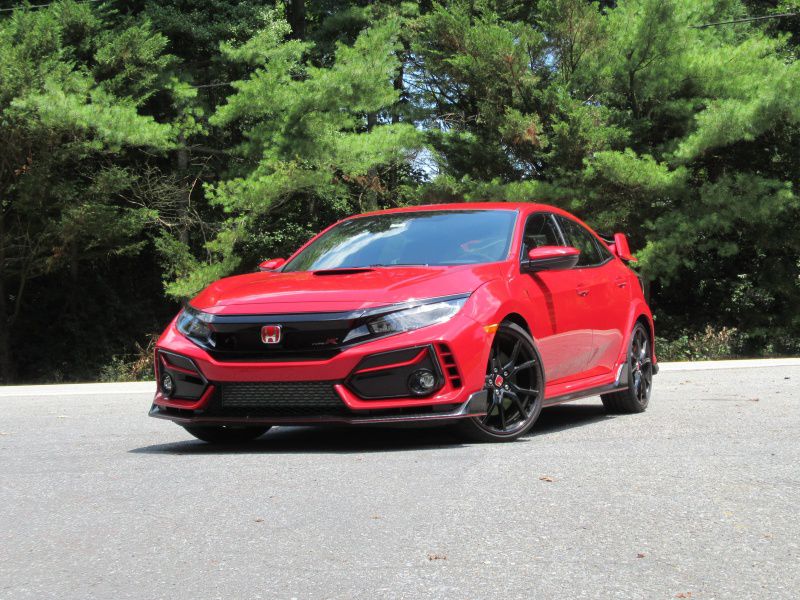
2020 Honda Civic Type R ・ Photo by Brady Holt
Any car can go out on a racetrack. Automotive journalism is famous for subjecting pickup trucks and minivans to the same performance testing that they’d conduct on a sports car. But few cars are optimized for the track — they can do it, sure, but they’re happier on a normal street. At the same time, when a car is designed for racetrack superiority, it often suffers from a bumpy, noisy ride and a cramped cabin when you just need to pick up some groceries, get to work, or even drive to and from the track.
The 2020 Honda Civic Type R, meanwhile, excels in both environments. It retains most of the comfort and practicality of a standard Honda Civic hatchback, but it dials in monster performance — 306 horsepower and a sport suspension. And this year brings further suspension upgrades, richer interior materials, more driver-assistance features, and slight styling tweaks. Is that worth the $36,995 price of admission? Let’s discuss the newly updated Civic Type R’s pros and cons to find out.
Not Subtle
The Honda Civic is best known as a mild-mannered economy car, but even the base sedan and coupe are exuberantly styled these days. The five-door hatchback variant takes that a step further, with so many cutouts swooping around on its front and rear bumpers that there’s more black than body color.
The Civic Type R is available only in this hatchback form. On top of the Civic hatchback’s already aggressive detailing, the Type R adds a massive rear wing spoiler, ground effects on every inch of the body, bulging fenders, three exhaust pipes at the center of the rear vehicle, vents on the hood and bumper, and red Honda badges. No one could accuse Honda of design restraint, especially on our Rally Red test car that screams “look how fast I can go!” There’s none of the subtle elegance you’d get on many $35,000-plus cars. But Honda says the Type R’s changes are primarily about function — keeping the car planted on the ground and sucking in air. This year’s front-end revision, a larger grille opening hidden below a slimmer black grille bar, is to keep the engine cooler during racetrack workouts.

Photo by Brady Holt
306 Horsepower
The Civic Type R’s engine hasn’t changed since the performance Civic debuted as a 2018 model, but it didn’t need to. This is a 2.0-liter turbocharged four-cylinder that makes a mighty 306 hp and 295 lb-ft of torque, which provides ridiculous speed in this little hatchback. For context, a base Civic LX has barely half this horsepower and even the sporty Civic Si has just 205 hp. The Type R rips to 60 mph in around 5 seconds.
No less impressive than the Type R’s sheer speed, though, is its civility. When you start many sporty cars, you get an engine growl that will wake babies up and down the block. This Civic provides just a gentle purr. Similarly, when you want to putter around town, the Type R is as gentle as any other Civic. It only wakes up when you want it to — and boy, can it wake up. You will need to know how to drive a stickshift, though, as every Type R uses a splendid six-speed manual transmission. A new feature provides synthetic sound inside the cabin, since some critics complained the Type R was too quiet; the volume changes with your driving mode.
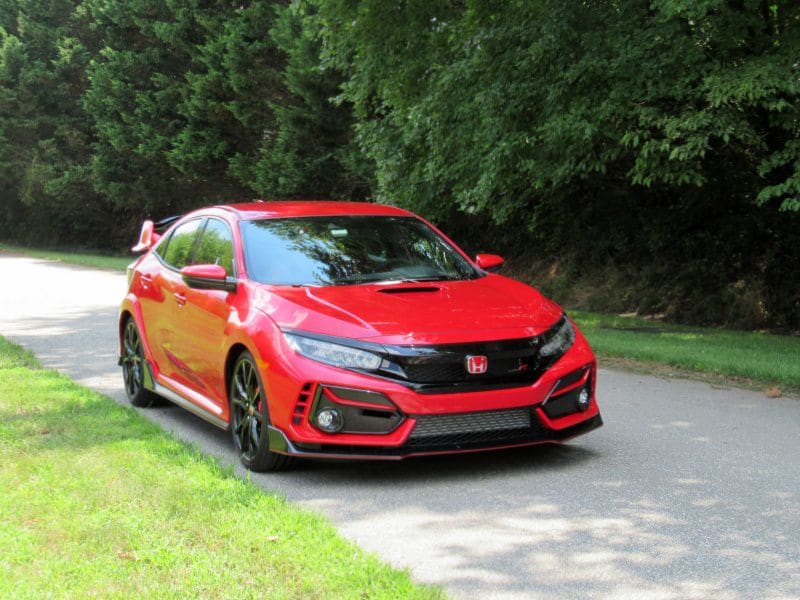
Photo by Brady Holt
Sharp Handling That Just Got Even Better
Powerful front-wheel-drive cars have a risk of torque steer: the engine’s power tugging the steering wheel to one side. To solve that, Honda cleverly moved the Civic Type R’s steering mechanism toward the center of the vehicle, helping the torque evenly reach the two front wheels without interfering with the sharp steering.
The Civic Type R has sharp responses even in routine driving, which we appreciate. Many track warriors provide only brute force, without the delicacy in their operations that make a car fun to drive safely on public streets. The standard sport seats are aggressively bolstered to keep you in place, but they’re not so tight that only the slim can apply. You can choose among three driving modes — Comfort, Sport, and Type R — which offer increasingly sharper steering and firmer tuning from the adjustable suspension. Comfort mode dulls the steering feel but is fine for highway cruising. In the other modes, the Type R is delightfully responsive and confidence-inspiring. This year, Honda replaced or stiffened key suspension components for superior ride, handling, and steering feel, a nice trifecta.
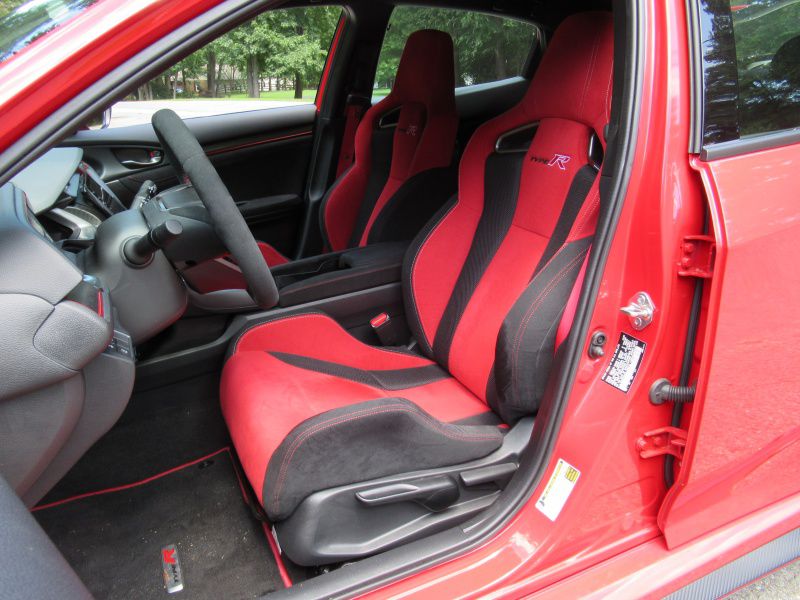
Photo by Brady Holt
Unexpectedly Polished
We mentioned how the Civic Type R’s engine is mercifully muted when you’re trying to be subtle. That’s the last thing we’d have expected from a car that looks like this. And the same applies to its ride quality.
The Civic Type R uses adaptive dampers in its suspension. Not only do they let you choose your comfort level, but the system also scans the road to prepare for upcoming bumps. For 2020, the system can prepare 10 times as fast. The result is an incredibly gentle ride for a sport-focused vehicle wearing performance tires and big 20-inch alloy wheels. We wish some luxury cars rode with the Type R’s composure. You feel bumps, especially in the Sport and Type R driving modes, but they never shattered the Honda’s confidence. Cabin noise isn’t perfect, though; we don’t mean the exciting sounds of a magnificent motor at work, but the drone of road noise and the engine running at 3,000 rpm to cruise at 75 mph. That said, most performance cars are louder still.
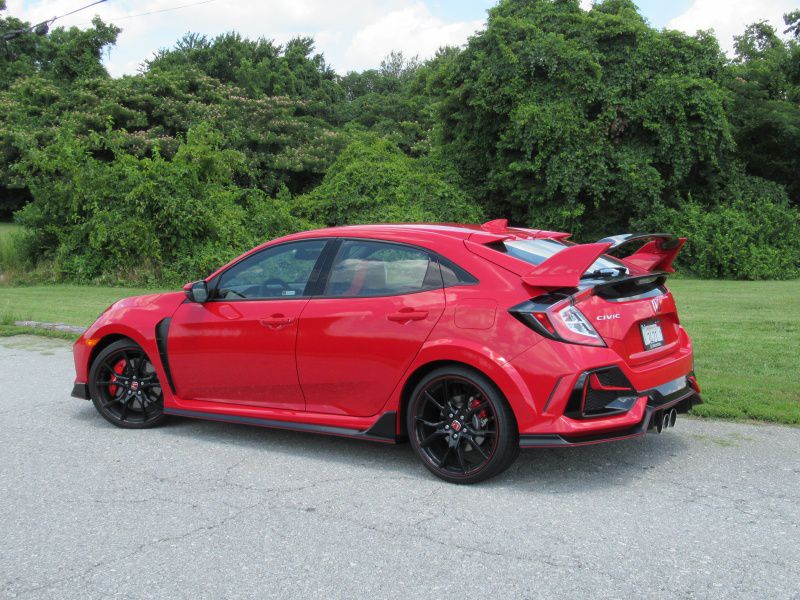
Photo by Brady Holt
Fast But Sensible
The Civic Type R’s civility continues with its useful interior volume. Every Civic hatchback has a generously spacious cabin with an airy feel, a big back seat, and more cargo space than some SUVs. That’s perfect if you’re looking for a fun daily driver rather than a weekend toy. The cabin is festooned with red — red front seats, red seat belts, and red trim on the steering wheel, dashboard, and floor mats — but once your vision clears, you find a deep center console bin and a useful cubby for your phone in the center stack. However, one way Honda made this space was by using a small electronic switch for the parking brake, to the chagrin of handbrake-turn enthusiasts.
Gas mileage is also decent for a 306-horsepower vehicle. The EPA estimates 22 mpg in the city, 28 mpg on the highway, and 25 mpg overall on premium fuel. We saw about 28 mpg in mostly rural driving plus stretches of highway cruising. That’s well below the EPA-estimated 36 mpg on regular fuel you’ll get from the most efficient Civic model, but not disastrously so.

Photo by Brady Holt
Interior Imperfections
Even if you don’t mind the Civic Type R’s aggressive use of red, there are some functional drawbacks to its interior design. The most notable is its infotainment system, which is still behind the times despite a valuable update last year.
The system uses a 7-inch touchscreen, which is on the small side by today’s standards. That leaves its functions crowded close together, requiring extra attention to tap the right one. The system is also uncommonly sluggish. Starting last year, Honda replaced the touch-sensitive power button, volume controls, and other functions with a physical knob and controls; while we appreciate the upgrade, the rest of the system still needs work. Fortunately, Android Auto and Apple CarPlay smartphone integration are standard. As an unrelated unforced error in the Type R’s cabin, the vehicle only seats four passengers rather than five like other Civic hatchbacks. Oddly, the center-rear position is replaced with a rigid plastic tray.
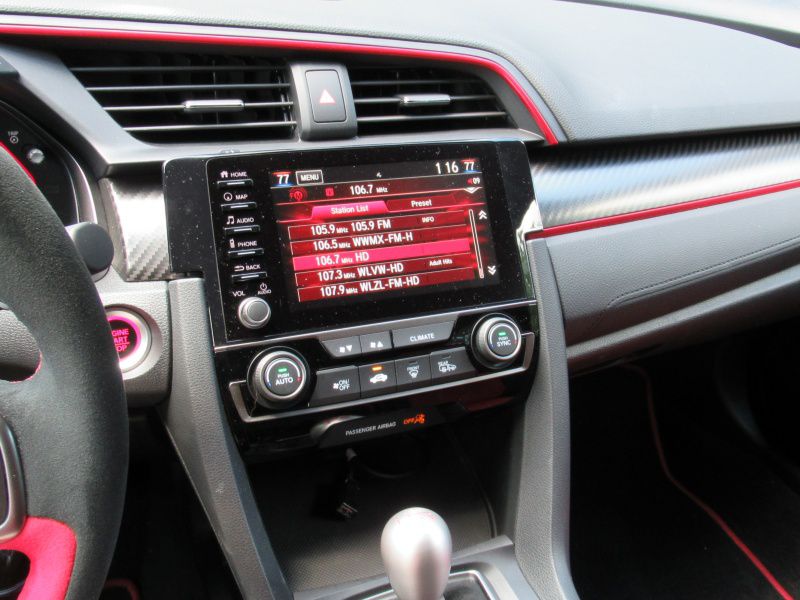
Photo by Brady Holt
The $38,000 Civic
Any time a performance car is built from a mainstream one, there’s a question of whether it’s overpriced. And the 2020 Honda Civic Type R starts at $36,995, which is just about $38,000 when you add the $955 destination charge. What do you get for $38,000 in a Honda Civic?
Well, first of all, the Type R is only sold in the Civic’s top Touring trim level, and even the regular Civic Touring hatchback costs more than $29,000. So that’s not such a crazy premium for the Type R’s extra go-fast bits. Standard features include suede and Alcantara interior trim (new to the steering wheel this year), a 12-speaker sound system, a navigation system, dual-zone automatic climate control, and push-button starting. For the first time, the Type R now also comes with the Honda Sensing suite of driver-assistance features: adaptive cruise control, automatic emergency braking, and lane-keeping assistance. Adaptive cruise control is a great set-it-and-forget-it system for a long freeway road trip, but the steering assistance just wanted to tug the car back and forth in its lane. We quickly turned it off.
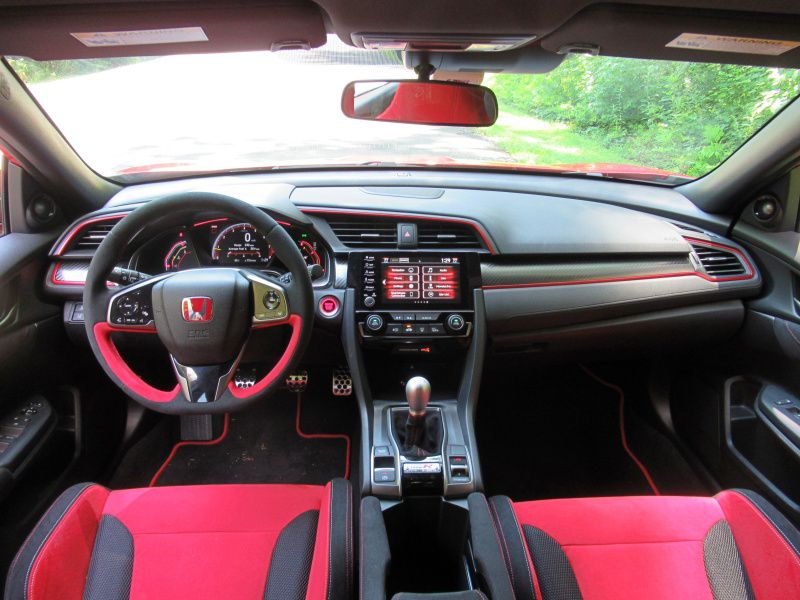
Photo by Brady Holt
Surviving Competitors
When the Civic Type R debuted as a 2018 model, its two closest rivals were the Ford Focus RS and Volkswagen Golf R — two ultra-performing all-wheel-drive hot hatches that have both been discontinued. Today’s top surviving sport compacts that blend high performance with everyday functionality are the Hyundai Veloster N, which is front-wheel-drive like the Civic Type R, and the AWD Subaru WRX STI.
The Veloster was always designed to look sporty, as the hot-hatch version of the Hyundai Elantra sedan. But it’s still more reserved and conventionally handsome than the attention-grabbing Civic Type R. And it’s less expensive, too, starting at just $27,600 with 250 hp or $29,700 with 275 hp. The Veloster N is neither quite as polished nor as outright capable as the Civic Type R, and it’s not as roomy, but it’s a tempting budget alternative. The WRX STI, meanwhile, is a 310-horsepower sedan derived from the circa-2012 Subaru Impreza. This is loud, fast fun, without the Veloster’s or Civic’s civility — for better or for worse. It’s also missing their hatchback versatility, and you have to work harder to extract its power. Pricing starts at $36,995.
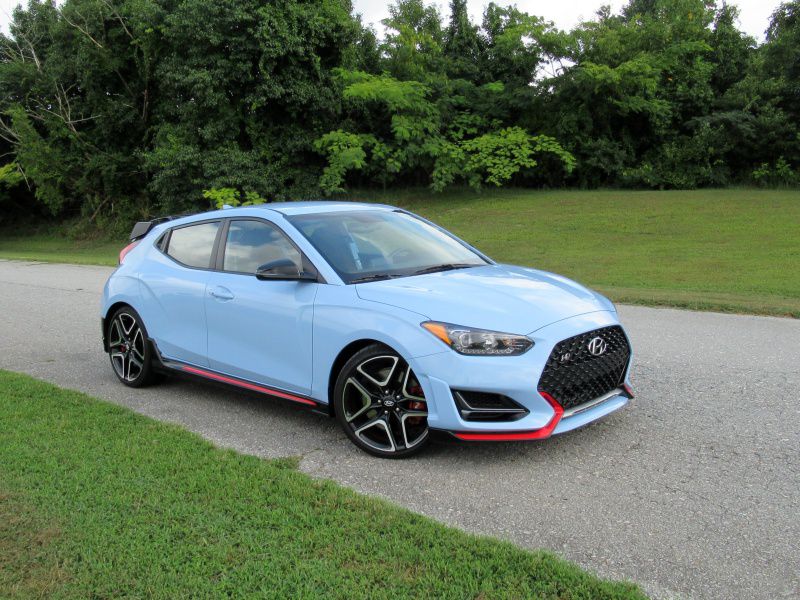
Photo by Brady Holt
Final Thoughts
The Civic Type R’s styling suggests a raw, juvenile performance car. The reality is anything but. This is a sophisticated machine with uncommon comfort, composure, and functionality, and that’s even before you consider that it’s also lightning-fast and incredibly agile.
Few cars are this much fun to drive without forcing you to sacrifice something, and the Type R is no different. But instead of making you accept a punishing ride quality or a cramped cabin, Honda asks you to accept some aesthetic immaturity and pay relatively big bucks for a Civic. This well-rounded performance package provides good reasons to do both.
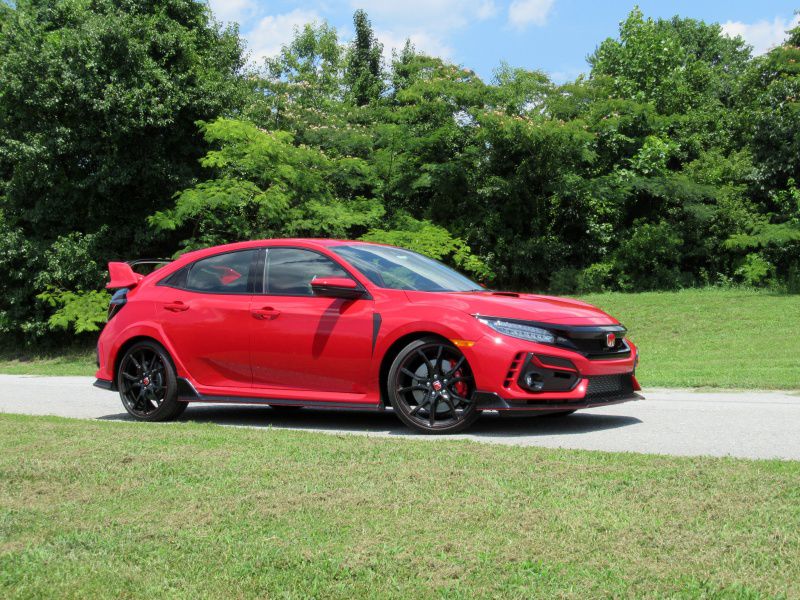
Photo by Brady Holt